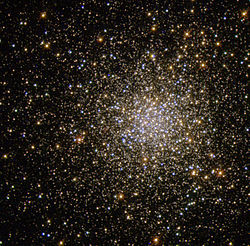NGC 5694 (also known as Caldwell 66) is a globular cluster in the constellation Hydra. It was discovered in 1784 by William Herschel.
| NGC 5694 | |
|---|---|
 The core of NGC 5694 imaged by the Hubble Space Telescope | |
| Observation data (J2000 epoch) | |
| Class | VII[1] |
| Constellation | Hydra |
| Right ascension | 14h 39m 36.5s[2] |
| Declination | −26° 32′ 18.0″[2] |
| Distance | 114,100ly[1] |
| Apparent magnitude (V) | 10.2[1] |
| Apparent dimensions (V) | 3.6′[1] |
| Physical characteristics | |
| Metallicity | = –1.74[3] dex |
| Estimated age | 13.44 Gyr[3] |
| Other designations | Caldwell 66 |
Characteristics edit
This globular cluster is located at a distance of 114,000 light-years (35,000 pc) from the Sun and 96,000 light-years (29,000 pc) from the Galactic Center[4] and is one of the oldest known globular clusters in the Milky Way Galaxy, forming nearly 12 billion years ago.[5]
Its chemical composition is highly peculiar, being highly (to nearly solar levels) enriched in alpha elements, suggesting an extragalactic origin before being captured by the Milky Way.[6]
See also edit
References edit
- ^ a b c d "Results for NGC 5694". SEDS NGC Catalog Online. Retrieved 2010-12-07.
- ^ a b "NGC 5694". SIMBAD. Centre de données astronomiques de Strasbourg. Retrieved 2010-12-07.
- ^ a b Forbes, Duncan A.; Bridges, Terry (May 2010), "Accreted versus in situ Milky Way globular clusters", Monthly Notices of the Royal Astronomical Society, 404 (3): 1203–1214, arXiv:1001.4289, Bibcode:2010MNRAS.404.1203F, doi:10.1111/j.1365-2966.2010.16373.x, S2CID 51825384.
- ^ Harris, W.E. (1996). "A Catalog of Parameters for Globular Clusters in the Milky Way". The Astronomical Journal. 112: 1487. Bibcode:1996AJ....112.1487H. doi:10.1086/118116.
- ^ "NGC/IC Project". Results for NGC 5694. Archived from the original on 2012-05-20. Retrieved 2010-12-07.
- ^ Mucciarelli, A.; Bellazzini, M.; Catelan, M.; Dalessandro, E.; Amigo, P.; Correnti, M.; Cortés, C.; d'Orazi, V. (2013), "NGC 5694: Another foster son of the Galactic halo★", Monthly Notices of the Royal Astronomical Society, 435 (4): 3667–3680, arXiv:1308.6653, doi:10.1093/mnras/stt1558
External links edit
- Media related to NGC 5694 at Wikimedia Commons
- NGC 5694 on WikiSky: DSS2, SDSS, GALEX, IRAS, Hydrogen α, X-Ray, Astrophoto, Sky Map, Articles and images
![{\displaystyle {\begin{smallmatrix}\left[{\ce {Fe}}/{\ce {H}}\right]\end{smallmatrix}}}](https://wikimedia.org/api/rest_v1/media/math/render/svg/4c0821bd80891e071c08e7c7ee8e022baedf522c)